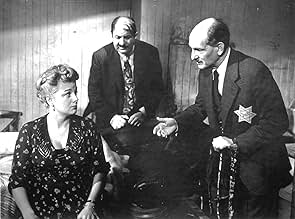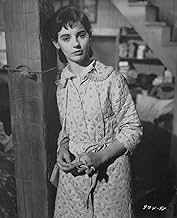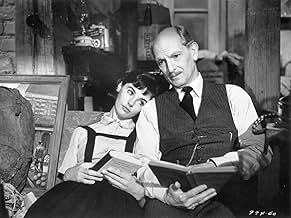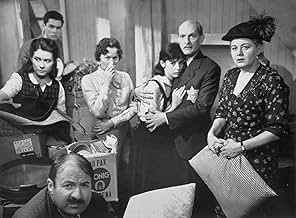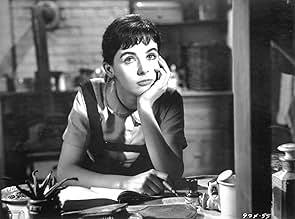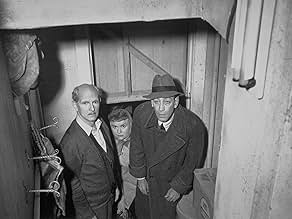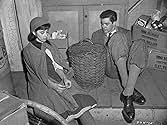Die erschütternde Geschichte eines jungen jüdischen Mädchens in Amsterdam, das sich zusammen mit ihrer Familie und deren Freunden auf einem Dachboden vor den Nazis verstecken muss.Die erschütternde Geschichte eines jungen jüdischen Mädchens in Amsterdam, das sich zusammen mit ihrer Familie und deren Freunden auf einem Dachboden vor den Nazis verstecken muss.Die erschütternde Geschichte eines jungen jüdischen Mädchens in Amsterdam, das sich zusammen mit ihrer Familie und deren Freunden auf einem Dachboden vor den Nazis verstecken muss.
- 3 Oscars gewonnen
- 9 Gewinne & 14 Nominierungen insgesamt
- Miep Gies
- (as Dody Heath)
- Dutch Workman
- (Nicht genannt)
- SS Man
- (Nicht genannt)
- Dutch Workman
- (Nicht genannt)
- SS Man
- (Nicht genannt)
- Sanne Devries
- (Nicht genannt)
- Workman in Shop
- (Nicht genannt)
- British Radio Announcer
- (Synchronisation)
- (Nicht genannt)
Empfohlene Bewertungen
The Diary is most important for its record of the daily lives of real individuals who lived in constant fear because of the Nazis and their irrational persecutions. It puts names and faces on the kind of human disaster that is all too often described in terms of mere numbers. The movie does well in bringing out this aspect of the diary, making the characters come to life in settings that are interesting, detailed, and believable. The photography also makes good use of the settings and the details.
The other significant aspect of the Diary is its portrait of Anne herself. Her writings combine observations on the overall situation with observations about her own life and self, with a surprising degree of perception. This does not come out so much in the movie, though of course this would be much harder to accomplish. Millie Perkins projects a rather different image from the original Anne, but then again, there is nothing really wrong with her performance in itself. She does make a sympathetic and generally believable heroine. The supporting cast generally does a good job. The fine character actor Joseph Schildkraut gives the best performance, as Anne's father Otto.
Overall, if viewed with reasonable expectations and evaluated apart from the book, this adaptation is an interesting and worthwhile movie.
When I was about the same age of Anne Frank, I read her book for the first time and I recall how sad I became. Then I read it at least two times more, and in the bottom of my heart, I was maybe expecting a happy ending and that this teenager and the other persons were saved after their tough struggle for survival. In the 90's, I visited her Museum and again I became very sad. Her story is certainly the saddest and most touching journal ever written and published, and shows how cruel the human being can be. This movie has been recently released on DVD in Brazil with 171 minutes running time, and I really liked it. The cinematography is very beautiful, and the tense and claustrophobic story highlights some of the most important parts of the book with minor modifications to keep the movie tense and in an adequate pace. The cast is excellent, and although having about twenty-one years old at that time, the mignon Millie Perkins performs a good Anne Frank. The person who betrayed Anne Frank and the other Jews has never been discovered. My vote is nine.
Title (Brazil): "O Diário de Anne Frank" ("The Diary of Anne Frank")
The story is based on a stageplay which was in turn based on the actual diary of Anne Frank, whose family (being Jewish) went into hiding in Nazi-occupied Holland in 1942, sharing a very small space with several others. As the title implies, the movie is largely about Anne. We watch her grow up in this claustrophobic setting - starting at age 13 and spending more than two years there until the group was discovered. Starting out as a child with a natural rebellious streak, Anne grows into a young woman, falling in love with a young man sharing the living quarters. Millie Perkins was excellent as young Anne, and I was impressed with Joseph Schildkraut as her father Otto, who was in the end the only survivor. The movie begins and ends with his post-war visit to the place where they were hidden, and his grief at being the only survivor among his family is powerfully portrayed. In general, all the performances in this were quite good, and there was a believable portrayal of the difficulties involved in so many people sharing so little space under such stressful circumstances, and there are a number of very suspenseful moments involved. It's a very moving story.
Three members of the original Broadway cast did their roles for the screen, Joseph Schildkraut, Lou Jacobi, and Gusti Huber. Joseph Schildkraut as Otto Frank is the backbone of the film, providing the moral authority in the cast. He's a teacher and a scholar and makes sure that even under these circumstances, the education of his daughters is not neglected. Gusti Huber is Mrs. Frank and Lou Jacobi is Mr. Van Daan.
The Van Daans and the Franks have been offered shelter in a third floor apartment that is kept secret by a hidden door in a factory owner. The owner Mr. Kraler played by Douglas Spencer is an anti-Nazi and has offered to keep these two Jewish families hidden for the duration of the war in Holland. For two years they live in that apartment and aside from radio news all they know of the outside world is that street in Amsterdam where the factory is located. Director George Stevens to keep the viewer from getting claustrophobic provides us with occasional shots of the outside street and canal. This film is the ultimate in cabin fever.
But it has to be so for the Van Daans and the Franks are hiding for their lives. It's a community of necessity that's created up in the third floor.
Young Millie Perkins does fine in the title role originated on Broadway by Susan Strassberg. She has an Audrey Hepburn like appeal, but never had the career Audrey certainly did. Her sister Margit is played by Diane Baker who's career was a bit more substantial. Two very normal average teenage girls, except that Anne has a talent for writing and observing.
The frightening thing about this film is the very ordinariness of the characters. What have these people ever done that the might of the Nazi war machine should be out looking for them? Some of them are certainly not noble specimens as the movie shows, but their lives are so humdrum like millions of us. Simply because for politics sake, someone was scapegoating a religion.
Ed Wynn as Drussel the dentist and Shelley Winters as Mrs. Van Daan were nominated for supporting players in the male and female categories that year. Wynn lost, but Winters won the first of her two Oscars for this film. Up to then Ms. Winters played some pretty brassy characters in film. She fought for and won this role and got acclaim worldwide for her portrayal as a wife and mother. It was a transition into those kind of roles for her.
So Anne observed and wrote about her impressions of what she saw and heard and the people around her for two years. In a sense this is like Moby Dick with the Pequod being the apartment and the white whale being the Nazis. Joseph Schildkraut is no Ahab, he's just trying to lead his community for survival.
When the Nazis come, Anne's diary is hidden and after the war one of the community comes back and like Ishmael retrieves the diary and very much tells the tale.
Anne's diary, the hopes and dreams of a teenage girl caught up in a world of hate she couldn't comprehend, is now classic literature. It serves as a dark reminder of the bestial nature we can sink to. And it reminds us that hope, courage and love can spring from the darkest places.
Go watch this sometime when you have 3 hours free.
8 out of 10 from me.
WUSSTEST DU SCHON:
- WissenswertesAudrey Hepburn was first offered the role of Anne Frank, and Otto Frank was among those who nominated her. She refused it for three reasons. Firstly, she had decided to accept the role in Tropenglut (1959). Secondly, she had lived in occupied The Netherlands during the war and had seen the Nazis carry out street executions and watched as they herded Jews onto boxcars to carry them to concentration camps. She knew that making the film would bring back memories that were far too painful for her. However, thirdly, she was 30 and felt that she was too old to play a teenage character convincingly on screen.
- PatzerAnne Frank was given the diary for her thirteenth birthday, a few days before they all went into hiding and not after going into hiding as depicted in the film.
- Zitate
Anne Frank: I know it's terrible trying to have any faith when people are doing such horrible... But you know what I sometimes think? I think the world may be going through a phase, the way I was with mother. It'll pass. Maybe not hundreds of years, but someday. - I still believe, in spite of everything, that people are really good at heart.
- Crazy CreditsAt the end, neither a "The End" credit nor a cast list appears, only the title of the film once more ("The Diary of Anne Frank").
- Alternative VersionenOriginally released at 170 minutes, then later cut and available only in 156-minutes version. Complete edition has been recently restored on video.
- VerbindungenFeatured in George Stevens (1984)
- SoundtracksBerg op zoom
(uncredited)
Traditional
Top-Auswahl
Details
Box Office
- Budget
- 3.800.000 $ (geschätzt)
- Laufzeit2 Stunden 32 Minuten
- Farbe
- Seitenverhältnis
- 2.35 : 1
Zu dieser Seite beitragen



